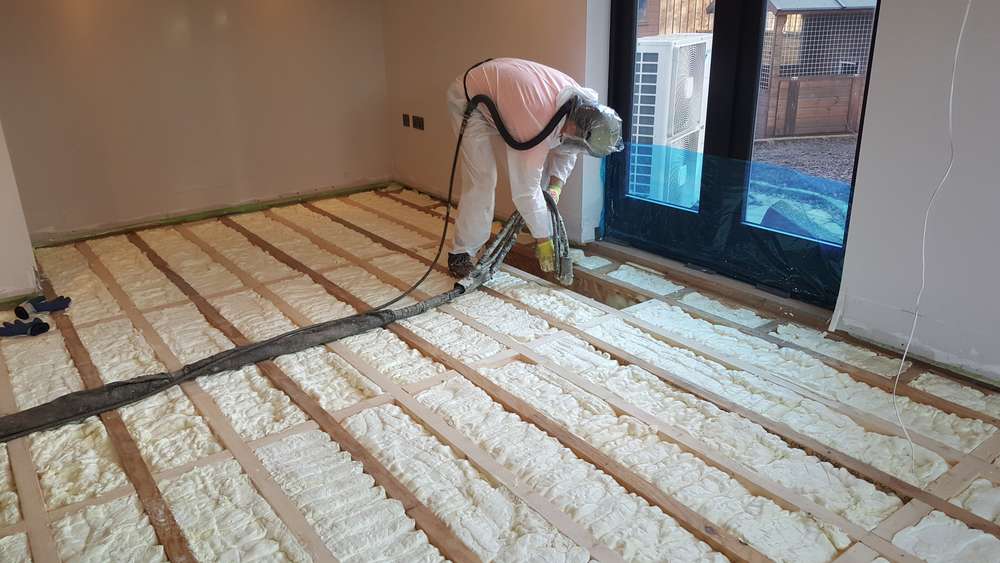Attic Spray Foam Insulation Dunshaughlin
Spray Foam Insulation Dunshaughlin
3 Bed Semi Attic Insulation Dunshaughlin

Attic Insulation Dunshaughlin
Spray foam works in many different conditions. Spray foam will benefit roofs and windows as well as interior and exterior walls.
Spray foam insulation can not only keep your house warm in winter, but it will also keep you cool in summer. Because of its “Cell” structure and composition, it allows moisture-laden air to escape. This helps the house breathe.
Benefits of Spray Foam Insulation for your home
Other uses include: commercial and industrial buildings; agricultural farms houses; sheds; shipping containers; vessels; and the refrigeration industry.
It creates an airtight barrier around your home, keeping out rain and cold winds. This is a major disadvantage over other insulation products currently on the market, as it allows heat to escape from your home.


Cost Price Of Spray Foam Insulation
Spray foam insulation can be regarded as the most efficient insulation material. Spray foam insulation has a higher U.Value than conventional insulating materials, such as fiberglass, rock wool, cellulose, and polystyrene board.
Spray foam insulation is also a good sound barrier. Spray foam insulation reduces outside noise significantly. This is especially advantageous for homes or companies that are located in densely populated cities or near airports.
Insulate Your Dunshaughlin Property Properly
It is often used to reduce sound travel from one room to another or between floors within the walls. It’s especially effective on bathroom walls because noises from flushing toilets or showers can make it a nuisance.
It’s simple to use, and it doesn’t disrupt your everyday activities.
In just one day, you can insulate an Irish home.
Encasing the pipes and insulation reduces noise coming from under-floor or in-wall piping.

Plan to store things in your loft or attic, so you’ll need to put boards on top of the joists. It is not enough to insulate between the joints if you do not cover the entire area.
It is much more effective than fibreglass, rock wool or polystyrene panels when used inside walls, roofs, floors and attics. Its dense composition, and its application process results in an envelope that is completely airtight. It stops sound infiltration from the outside environment such as traffic or pedestrianised streets.
It also prevents sound generated from within a building from reaching adjacent floors or the floors below them. Spray foam insulation would dramatically reduce the noises that are often generated in a structure.
Spray foam insulation, which is flexible and packed with millions of tiny air bubbles, absorbs vibrations from the floor and wooden members. It also inhibits sound transfer through the floor. Spray foam insulation reduces sound transmission by sealing any cracks or crevices that airborne noises can travel through.
Spray foam insulation also dampens, if it is not eliminated completely, sounds that could originate from beneath a floor such water flowing through pipes. It completely covers the pipes and prevents them from rattling. It also eliminates the sound caused by hot water flowing through pipes. The heating system heats wooded Joists, causing them to expand, creak and groove.
It also keeps heat from escaping to upper floors, which causes lower floors to become colder, which in turn makes them require more heat to keep warm. The upper floors become too hot.
It is possible to insulate lofts if they are accessible and have no damp or condensation issues.
Uninsulated homes lose 25% of their heat through their roofs. Insulating your flat roof, attic, or loft can help reduce heat loss and decrease your heating costs.
If you have access to your loft joists and it is easy to use, mineral wool insulation rolls can be used. The insulation layer is placed between the joists (the horizontal beams that make the loft’s floor) and then another layer is applied at right angles to cover all the joists.
You can raise your floor to provide enough insulation. You can install timber battens on the floor joists. Or, you can use purpose-built legs made of plastic that fit on the leg and support the floor. To prevent condensation from forming on the boards’ undersides, it is important to ventilate the air gap between insulation and boards.
It is important to not squash the mineral fiber when you put the boards on top. This can reduce its insulation.
Insulation stops heat loss from living spaces. By making your loft space cool, you can prevent damp or condensation from developing. You may need to increase ventilation if you install loft insulation yourself.
The insulation can be fitted between and over the roofing rafters, which are the flat timbers that support the roof. You can either use rigid insulation boards which are cut precisely to fit your loft, or spray foam insulation between the roof rafters.
Some companies might offer to repair your roof if it is damaged or leaky. They will spray foam insulation directly onto the roof’s underside without fixing the problem. This is not something we recommend. You must ensure that your roof is in good condition before you apply insulation.
If you plan to use your loft for heating, you’ll need to make a room in the roof.
You will need to insulate the loft walls and ceilings if you intend to use it as your living space.
To keep your home fresh, dry, and healthy, air must flow in and out. An experienced installer will not block or seal any intended ventilation. When DIY insulation is done, ensure that you don’t cover any vents grilles or airbricks.
If the loft is not easy to access, a professional can install blown insulation. This specialist will use special equipment that can blow insulation into difficult spaces. They can use mineral wool fibres or treated cellulose or polyurethane.
Flat roof insulation can save you as much on heating costs than loft insulation. The extent of the flat roof on your property will impact how much savings you receive.
If the loft is accessible, has no damp problems, and is not on a flat roof you can likely insulate it yourself. A professional installer is required for cases where damp problems are present or complex insulation systems are needed.
Cold draughts could be caused by the cooler loft air. You can prevent this by fitting an insulated loft hatch, and placing strips of draught-exclusion material around hatch edges.
Insulating your ground-floor is a great idea to keep your property warm and lower your energy bills.
Insulating your loft is a great way to cut down on heating costs and save energy. It also keeps the home warm in winter. Even if the loft already has insulation in place, it is essential to use it at its best.
Loft floor rolls – These are the classic option. They are laid along the loft’s floor. They are less difficult to lay than insulated boards. These rolls can be used to create top and base layers. To create a storage platform, they can be boarded using stilts.
These items and tips are not included in the article’s list. Make sure you read the entire article to ensure you are fully equipped to insulate your loft floor safely.
While insulation may be present in most homes, it may not have the right level of effectiveness. This could be due either to storage boards being placed on top of it, or because the insulation has not been maintained for a long period. Older properties may have a loft floor as low as 25mm deep.
It doesn’t have to be removed from your loft floor insulation. To reach the recommended level, simply add one or more layers to it. You will find more information about the recommended amount in the article.
The spacing of your loft floor’s joists will determine the width roll you choose. This is because insulation is rolled between these joints. It is best to choose one that matches your joist spacing. This reduces the need for trimming.
The insulation’s required thermal resistance. Alternativly, you can measure the insulation’s thickness if you are only laying loft rolls. Refer to the section titled “How to calculate the loft floor insulation thickness required” for more details.

Parkhill, Dublin
01 5255297


